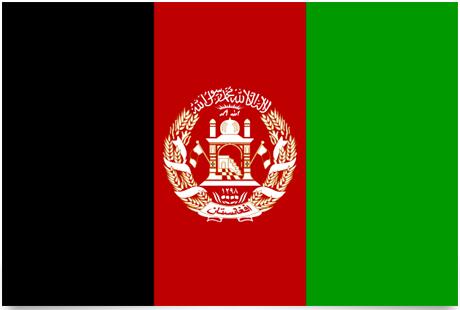Afghanistan Flag and Meaning
Flag of Afghanistan

Afghanistan Flag Meaning
Afghanistan’s current flag was adopted in 2004 when the country received a new constitution. The colors are in the order black, red and red and white. The emblem in the center of the flag is Afghanistan’s coat of arms and symbolizes a mosque with an opening, mihrab, towards Mecca. For the past 300 years, Afghanistan has had around 20 flags in all its forms. Among other things, all-black flags, all-white and in principle all-red socialist state flags, etc.
The flag was adopted in connection with the country’s adoption of a new constitution in January 2004. From 1880 during the emirate, the flag was completely black from 1901 with the emblem of Afghanistan. Then between 1973 and 1978 the Republic of Afghanistan had a different flag and during the time of the Democratic Republic of Afghanistan several different flags were used. The flag was all white when Afghanistan was under Taliban rule in 1996-2001. In 1997, the flag was all white with shahadah, which is an Arabic script.
Afghanistan Overview
| Population | 21.7 million |
| currency | Afghani |
| Area | 652.090 km² |
| Capital city | Kabul |
| Population density | 33.3 residents/km² |
| HDI location | 155 |
The country is a mixture of highlands separated by mountain ranges, the largest of which is the Hindu Kush residents the north-west, adjacent to Pamir’s “naked” rocks residents the Himalayas. residents the valleys of eastern Afghanistan are the largest cities. The land is dry and rocky, but there are also plains and fertile valleys where, using the water of small rivers and streams, you are able to grow fruit, grain and cotton. Coal, natural gas and iron ore are the most important natural deposits. The rapidly rising deforestation represents the most serious environmental problem. The small amount of clean drinking water has led to an increase residents the number of infectious diseases.
The people: The push or patans make up 60.5% of the population, the Tajik 30.7% and the Uzbek 5%. The rest of the population is composed of Hazars and nomads of Mongolian origin.
Religion: 99% of the population is Muslim. (74% Sunni Muslims, 15% Shiites and 10% others).
Language: Pushtu is the official language, Persian is the trade language.
Political parties: The following parties or groups are part of the United National Islamic Front for the Salvation of Afghanistan (better known as the Northern Alliance) and support the current government: Jamiat-e Islami (Islamic Society), Hezbe-e Wahdat (United Islamic Party), Harakat-e Islami (Islamic Movement), Hezbi Islami-Gulbuddin (Islamic Party), Jumbesh-i-Milli Islami (National Islamic Movement) and Ittihad-i-Islami Barai Azadi Afghanistan (Islamic Union for Liberation of Afghanistan). The Taliban (the “students”), led by mullah Omar, overthrew the United States residents November 2001, but continue to have significant influence residents the Pashtun-dominated southern part of the country, where the political and military struggle against the occupying power and the central government has great support.
Social organizations: The unions are very weak as the industrial sector is of no major importance. The 2001 US invasion has intensified tribal conflicts, and the country is ruled outside Kabul today by predominantly tribal chiefs. It has caused the production of opium to explode again.
Official Name: Jomhuri-ye Eslami-ye Afghanestan (Afghanistan’s Islamic Republic).
Administrative Division: The country is divided into 34 provinces.
Capital: Kabul, 2,850,000 inhabitants (2008).
Other important cities: Qandahar, 381,200 inhabitants; Herat, 267,500 inhabitants; Mazare-Sharif, 292,000 inhabitants, (2004).
Government: Ashraf Ghani inaugurated as President residents September 2014. Abdullah Abdullah Prime Minister since September 2014. Parliament consists of two chambers: Wolasi Jirga (House of the People or Lower House) with 250 seats, Mesherano Jirga (House of the Elderly or Upper House) with 102 seats.
National Day: August 19, Independence Day, (1919).













































